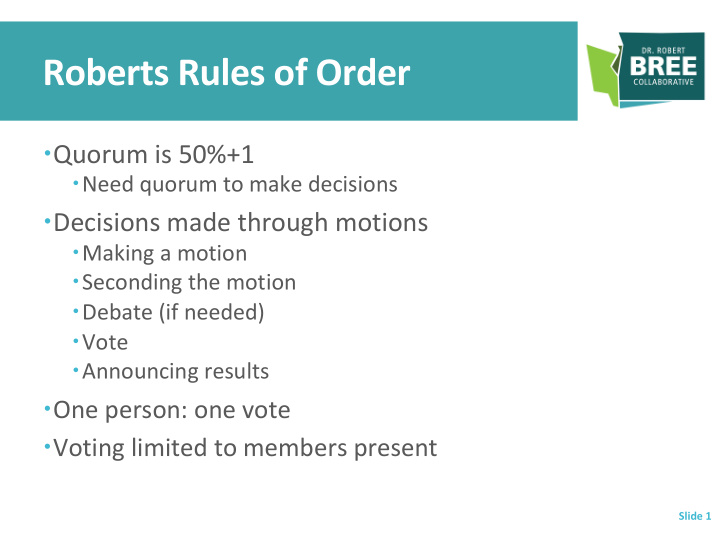



Roberts Rules of Order Quorum is 50%+1 Need quorum to make decisions Decisions made through motions Making a motion Seconding the motion Debate (if needed) Vote Announcing results One person: one vote Voting limited to members present Slide 1
Background 2011 Health Care Environment Low Quality High Cost Broken Healthcare System Bad Outcomes Advanced Imaging Management Project Bree Collaborative Slide 2
Background Members and Topic Selection Public Purchasers Private Health Purchasers Identify health Plans (Employers care services with House Bill high: 22 1311 • Variation Members • Utilization Delivery Without producing Systems better outcomes Physicians and Hospitals QI Organizations Slide 3
Developing Recommendations Reimbursement Models Transparency/Tracking Public Comment Centers of Excellence Recommendations to improve health Shared Decision Making Clinical care quality, Existing Guidelines Committee outcomes, and affordability Published Evidence Meeting Monthly for 9-12 Months Programs and Policies WA State Agencies Broader Health Care Community Slide 4
28 sets of recommendations + 4 being developed Procedural (surgical) Pain (Chronic and Acute) Bundled payment models and warranties: Collaborative care for chronic pain (2018) Total knee and total hip replacement (2013, re- Low back pain management (2013) review 2017) Opioid prescribing metrics (2017) Lumbar fusion (2014, re-review 2018) Opioid prescribing for postoperative pain (2018) Coronary artery bypass surgery (2015) Opioid prescribing in dentistry (2017) Bariatric surgery (2016) Long-term opioid prescribing management Hysterectomy (2017) (2019) Data collection on appropriate cardiac Behavioral Health surgery (2013) Integrating behavioral health into primary care Obstetrics (2016) Obstetric care (2012) Addiction and substance use disorder screening Maternity Bundle (2019) and intervention (2014) Aging Suicide care (2018) Advance care planning for the end-of-life Treatment for opioid use disorder (2016) (2014) Prescribing antipsychotics to children and Alzheimer’s disease and other dementias adolescents (2016) (2017) Risk of Violence to Others (2019) Palliative Care (2019) Oncology Hospital readmissions (2014) Oncology care (2015) LGBTQ health care (2018) Prostate cancer screening (2015) Shared Decision Making (2019) Slide 5
Developing the Guidelines Reproducible Process Identify problem(s) Develop framework Clear, based in evidence Inclusions v exclusions Guideline has to be attractive to clinicians, payers, and patients Collaboration always means compromise Slide 6 Weir
Key Points Bottom-up approach Iterative process – identifying gaps in expertise – new members Patient and community voice Standardization v individualized medicine Involve primary care Guideline development v implementation Slide 7 Weir
2020 Topics Chemotherapy Colorectal Cancer Primary Care Reproductive Health Care Slide 8
Open Public Meetings Act Required of Bree Collaborative meetings and workgroup meetings Allows the public to view decision-making process Training Slide 9
Roster Slide 10
Conflict of Interest Form Slide 11
Proposed Work Plan Monthly meetings starting in January Present Roster and Charter January Engage experts, talk through barriers, review evidence + best practice Final product Fall 2020 Slide 12
Recommend
More recommend